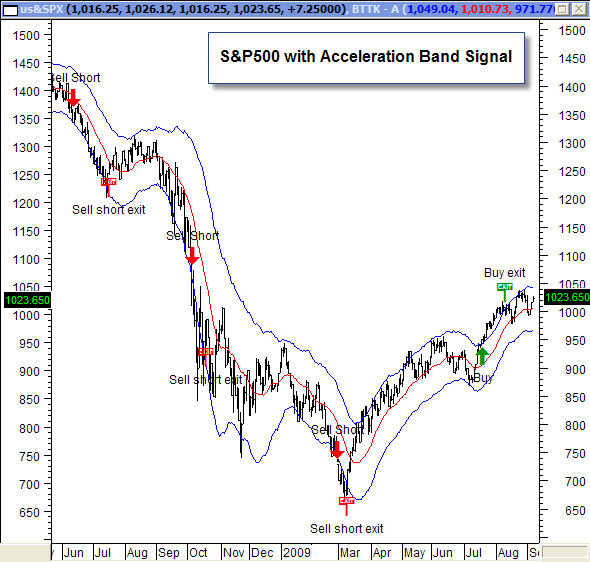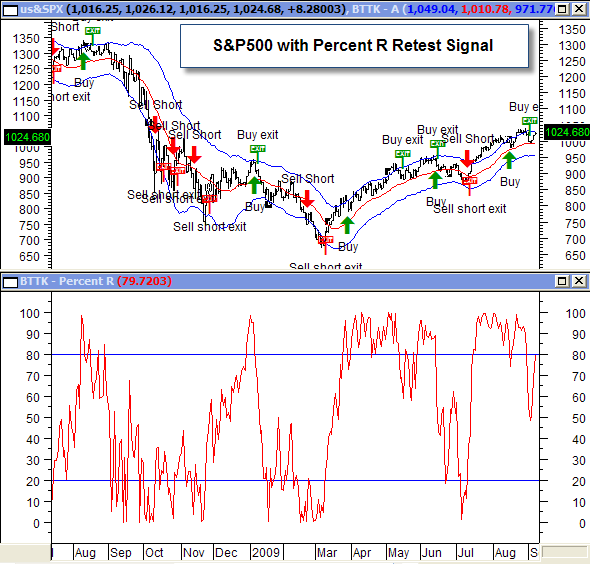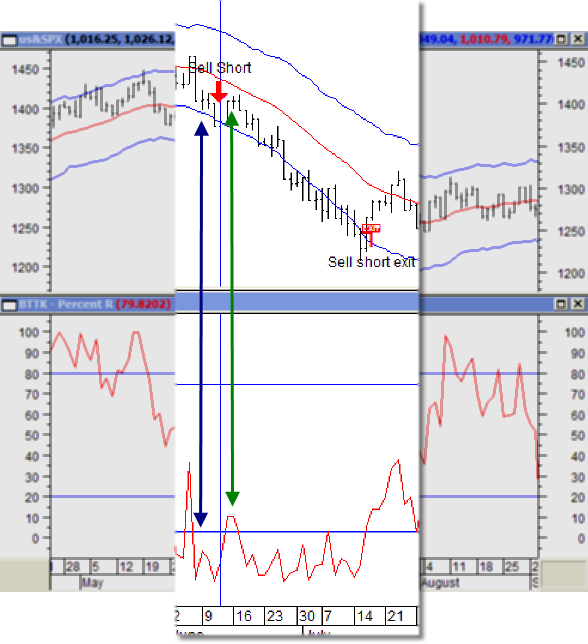Creating an Effective Trading System: Acceleration Bands and Williams Percent R
Creating an Effective Trading System: Acceleration Bands and Williams Percent R
Try This Simple Trading System
For option traders, correctly forecasting short-term price action is imperative to long-term success and, in my view, technical analysis is the best way to achieve this. Many would say the "Holy Grail" of technical analysis is to find true "leading" indicators ... those that point to directional movements and trends as they are occurring or before they occur, not lagging indicators that show what has already occurred. I've tested and designed hundreds of technical indicators over the years, and I want to share with you one of my trading systems that uses two of my favorite and time-tested indictors. The two indicators? One is Acceleration Bands, which I created. The other is Williams Percent R, which I have modified and created specific rules to utilize that are different than is seen in normal trading systems.
A major problem that many traders have is too many signals. In other words, their criteria needs to be tightened and refined. As many of you already know, I look for the Big Trends that rarely occur, this helps me leverage my capital while reducing the number of total trades. Now, don't be fooled, there is no fool-proof system out there ... so risk control is an important part of any technical system. In life, it's good to be an optimist, but excessive optimism in system development can easily lead to ignoring the risks and the weaknesses in your trading system. All systems have weaknesses. Make sure your systems have a risk control element to it.
Today I want to share with you a system that uses only two indicators, Acceleration Bands and Williams' Percent R - remember keep your system simple. First, it's important to describe each system independently to see the strength and weaknesses of each.
Acceleration Bands area a proprietary technical indicator we created, available in the MetaStock Big Trends ToolKit.
Description: Adaptive bands that contain 95% of price action usually used in 20 or 80 bar periods. Trading signals occur when price action is confirmed outside the bands. This indicator targets the top 5% of moves, keeping traders focused on the best trends.
The 20 Bar Acceleration Band Expert Advisor (SPX chart below) shows buy and sell signals based on my system. Notice that in the 14 months shown, the S&P 500 (SPX) (SPY) only exposed a signal 4 times, each was profitable. This depicts the 5% theory well - Acceleration Bands highlight only the extreme moves for option traders. The issue many traders face is really two-fold; many traders want more signals and the entry point can use some refinement. Like the Yin & Yang relationship, I've developed a system that combines Acceleration Bands with Williams' Percent R to remove any weaknesses and refine trading signals. Let's take a look at how it works.
SPX Chart with Acceleration Band Signals
 Williams' Percent R is a traditional technical indicator. The Big Trends Williams' %R method is available in the Big Trends Toolkit with two separate systems based on breakout and retest (lower risk entries) methods. We have smoothed out and modified Williams' Percent R to make it a better and more usable trading vehicle. Also see our Percent R The BigTrends Way course.
Description: Larry Williams created the Percent Range oscillator to highlight overbought versus oversold levels in securities. Traditionally overbought connotates a long exit or sell short entry as oversold would insinuate the opposite, however, we in general consider overbought to be bullish and oversold to be bearish. The Big Trends Percent R system targets the top 20th percentile and bottom 20th percentile.
In the chart below we have the Expert Advisor for Big Trends ToolKit (BTTK) Percent R Retest System applied to the S&P 500. My first impression is that there may be too many signals with 11 trades in 14 months (compared to 4 with the Acceleration Bands). The Percent R Retest System targets lower risk entry points by signaling buy or sell-short signals after a corresponding breakout confirmation occurs. These pullbacks, or retests, are patterns that help identify fast moving trades that are immediately profitable. If they do not move in the expected direction immediately an exit signal is triggered for effective risk control.
SPX Chart with Percent R Retest Signals
Williams' Percent R is a traditional technical indicator. The Big Trends Williams' %R method is available in the Big Trends Toolkit with two separate systems based on breakout and retest (lower risk entries) methods. We have smoothed out and modified Williams' Percent R to make it a better and more usable trading vehicle. Also see our Percent R The BigTrends Way course.
Description: Larry Williams created the Percent Range oscillator to highlight overbought versus oversold levels in securities. Traditionally overbought connotates a long exit or sell short entry as oversold would insinuate the opposite, however, we in general consider overbought to be bullish and oversold to be bearish. The Big Trends Percent R system targets the top 20th percentile and bottom 20th percentile.
In the chart below we have the Expert Advisor for Big Trends ToolKit (BTTK) Percent R Retest System applied to the S&P 500. My first impression is that there may be too many signals with 11 trades in 14 months (compared to 4 with the Acceleration Bands). The Percent R Retest System targets lower risk entry points by signaling buy or sell-short signals after a corresponding breakout confirmation occurs. These pullbacks, or retests, are patterns that help identify fast moving trades that are immediately profitable. If they do not move in the expected direction immediately an exit signal is triggered for effective risk control.
SPX Chart with Percent R Retest Signals
 Notice above that we also have 20 Bar Acceleration Bands applied to the price action -- my favorite system employs both Percent R and Acceleration Bands; reducing the number of trades while only trading the best pullbacks. I focus on Percent R retests within Acceleration Band signals. Let's take a look at an example of this signal further below.
When developing a system I look for winners that are at least twice the size of losses and a minimum 50% winning average, however, I've found that 60% winning average is optimum and realistic. That's why using Acceleration Bands and Williams' Percent R has become one of my favorite two indicator systems. Acceleration Bands highlight extremely strong moves, while Percent R Retest Method highlights low risk entry points within those Accelerations. In addition, I found that this system works particularly well on individual stocks, which typically provide more Acceleration signals than market averages like the S&P500.
For ease of learning I want to show you a quick example of a signal using both indicators within the same time frame as the charts above on the S&P500 . In the chart below we have the Acceleration Band Expert Advisor (20 Bar) exposing a sell-short signal based on momentum. Notice that in the days after extreme selling signals an Acceleration short signal, we see a bounce, or retest, in price action. This typically occurs from value seekers, however, we know that once the trend has Accelerated thus far it's probable to continue.
SPX Chart with Combined System
Notice above that we also have 20 Bar Acceleration Bands applied to the price action -- my favorite system employs both Percent R and Acceleration Bands; reducing the number of trades while only trading the best pullbacks. I focus on Percent R retests within Acceleration Band signals. Let's take a look at an example of this signal further below.
When developing a system I look for winners that are at least twice the size of losses and a minimum 50% winning average, however, I've found that 60% winning average is optimum and realistic. That's why using Acceleration Bands and Williams' Percent R has become one of my favorite two indicator systems. Acceleration Bands highlight extremely strong moves, while Percent R Retest Method highlights low risk entry points within those Accelerations. In addition, I found that this system works particularly well on individual stocks, which typically provide more Acceleration signals than market averages like the S&P500.
For ease of learning I want to show you a quick example of a signal using both indicators within the same time frame as the charts above on the S&P500 . In the chart below we have the Acceleration Band Expert Advisor (20 Bar) exposing a sell-short signal based on momentum. Notice that in the days after extreme selling signals an Acceleration short signal, we see a bounce, or retest, in price action. This typically occurs from value seekers, however, we know that once the trend has Accelerated thus far it's probable to continue.
SPX Chart with Combined System
 The blue arrow shows us where Percent R initially confirms bearish activity (prior to Acceleration signal) , and we know that any Percent R spike above 20% is now a qualified retest. Furthermore, if the retest occurs after the Acceleration Band signal it's a lower risk entry within a highly probable signal. Adding the Percent Retest filter to your Acceleration bands will help you be patient for those lower risk entries after momentum has confirmed; while Acceleration signals help you identify weaker trends where retest become reversal.
As I've mentioned, in general keep a trading system simple - I have found that the unique combination of Acceleration Band breakouts and Williams Percent R re-tests (utilizing Big Trend Percent R methods) is a very effective trading tool & system . I encourage you to start testing this on your favorite stocks as it has helped me increase my winning percentage, while reducing those whipsaws that many traders experience from Acceleration Bands alone.
Trade Well,
Price Headley
BigTrends.com
1-800-244-8736
The blue arrow shows us where Percent R initially confirms bearish activity (prior to Acceleration signal) , and we know that any Percent R spike above 20% is now a qualified retest. Furthermore, if the retest occurs after the Acceleration Band signal it's a lower risk entry within a highly probable signal. Adding the Percent Retest filter to your Acceleration bands will help you be patient for those lower risk entries after momentum has confirmed; while Acceleration signals help you identify weaker trends where retest become reversal.
As I've mentioned, in general keep a trading system simple - I have found that the unique combination of Acceleration Band breakouts and Williams Percent R re-tests (utilizing Big Trend Percent R methods) is a very effective trading tool & system . I encourage you to start testing this on your favorite stocks as it has helped me increase my winning percentage, while reducing those whipsaws that many traders experience from Acceleration Bands alone.
Trade Well,
Price Headley
BigTrends.com
1-800-244-8736
